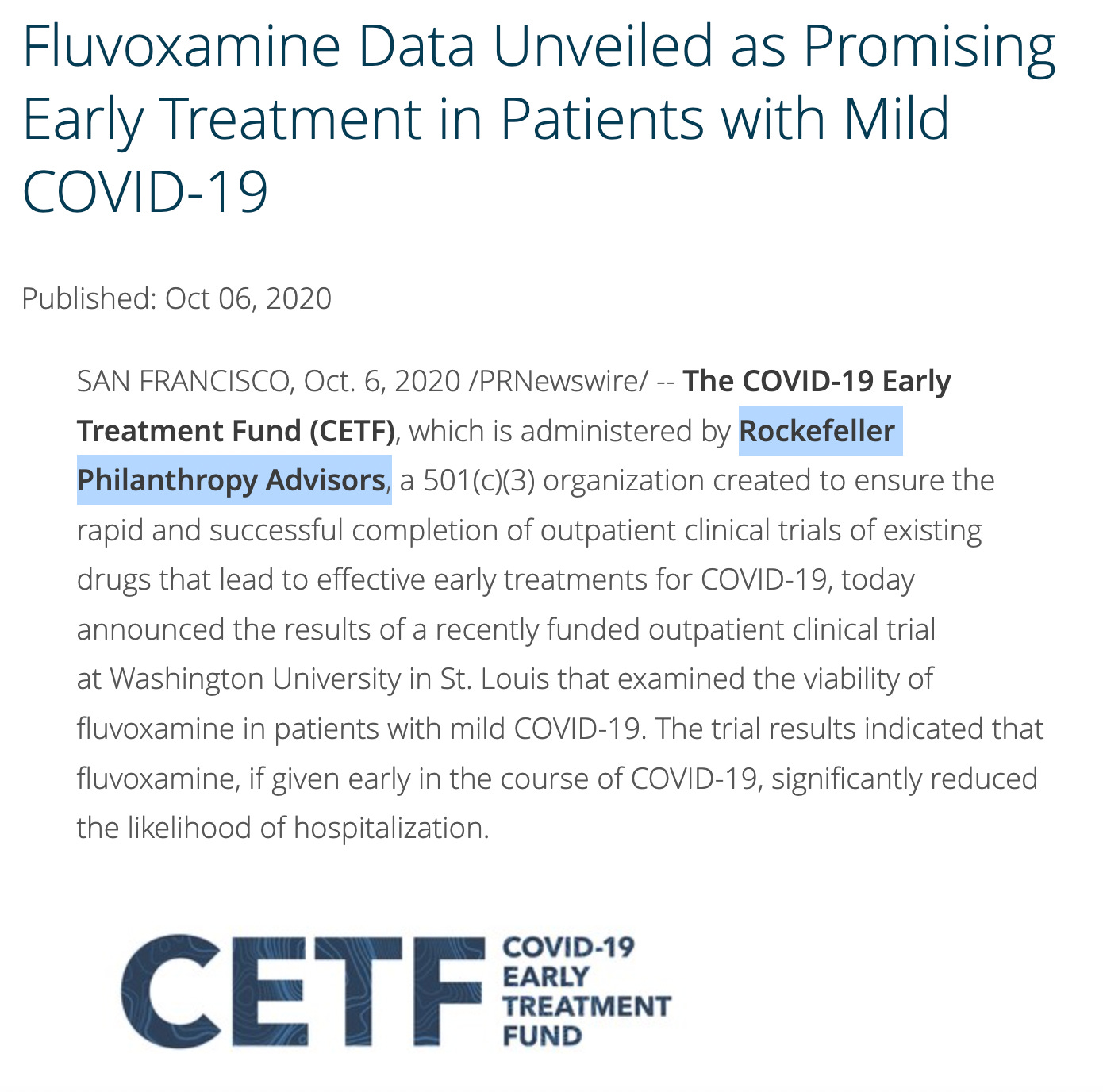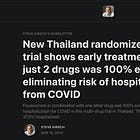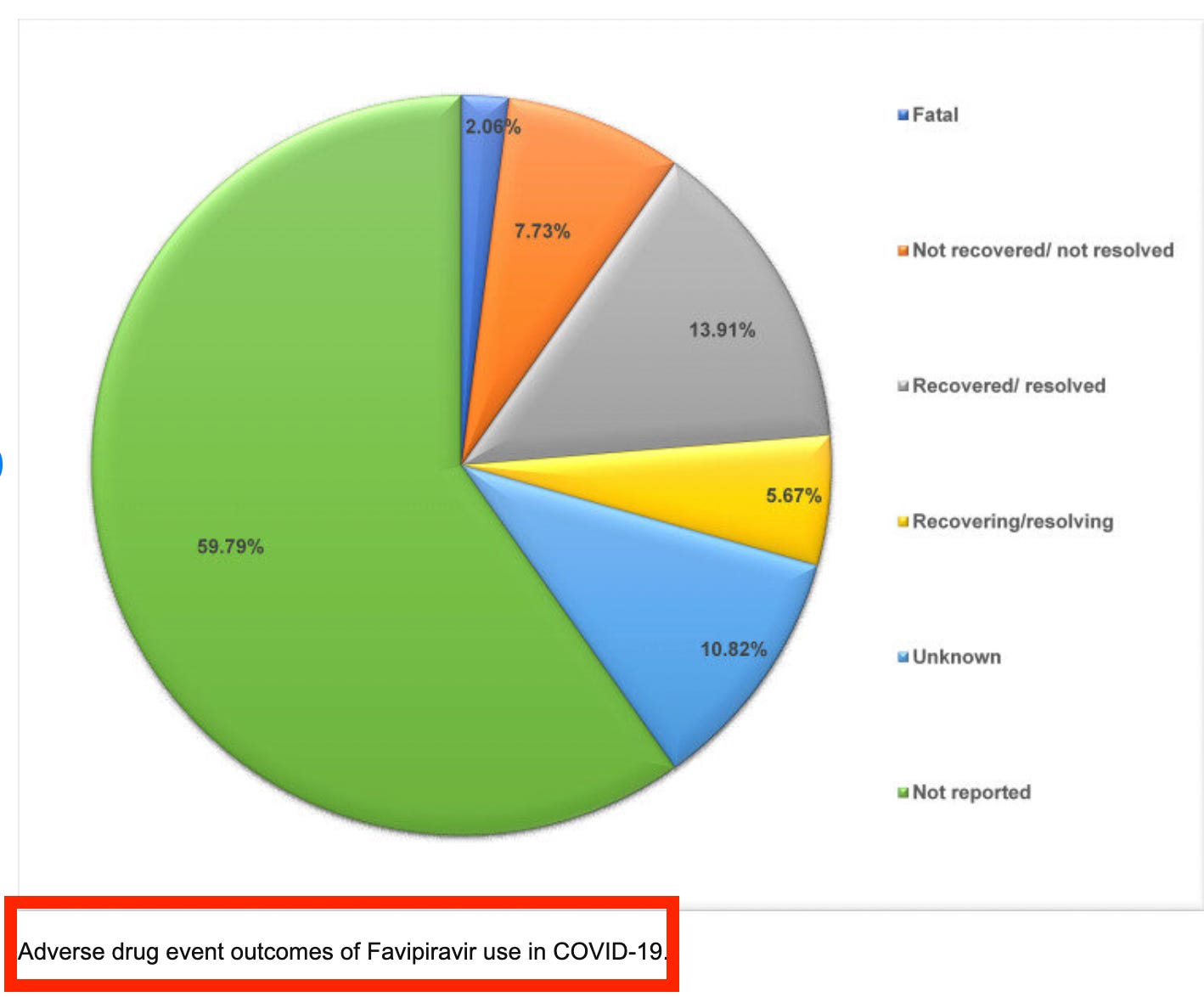I wrote last week in response to a post by Steve Kirsch regarding a study out of Thailand that boasted 100% efficacy of fluvoxamine in combination with one of several other drugs to treat Covid.
Steve was kind enough to drop by the comment section which I’ll share momentarily.
But first let’s talk about the study.
There were 995 participants, randomized into 5 arms:
fluvoxamine alone
fluvoxamine + bromhexine (bromhexine is a drug that aids the body's mucus-clearing processes in the respiratory tract. It is used to relieve chest congestion.)
fluvoxamine + cyproheptadine (cyproheptadine is a first-generation antihistamine.)
niclosamide + bromhexine (niclosamide is an antihelminthic/anti-parasitic used for the treatment of tapeworm infections.)
standard care (favipiravir) (favipiravir is an antiviral used to manage influenza, and that has the potential to target other viral infections.)
Please note that there was no placebo control in this study.
Hi Steve. Steve loves fluvoxamine for Covid.
Tech Entrepreneur Crusades for SSRI as COVID Therapy
— How multimillionaire Steve Kirsch and the COVID-19 Early Treatment Fund have promoted fluvoxamine
Steve Kirsch: $25,000 to Anyone that Proves Fluvoxamine Needs more Data for COVID-19 Treatment

Steve’s comment:
We do it because 1) we've checked for interactions, 2) the dosage recommended is half the normal dosage, and 3) it's for a VERY small amount of time and 4) because it WORKS.
Mostly #4.
Duh.
Let’s go through this.
“we've checked for interactions”
There are 696 medications listed as having potentially deleterious interactions with fluvoxamine. Assuming that participants were not taking those medications, and given that individuals were excluded from participation if “deemed by the recruiting clinician to have significant exclusionary comorbidities”; one could potentially conclude that participants in the trial were in reasonably good overall health, and therefore not at significant risk for severe Covid outcomes.
“the dosage recommended is half the normal dosage”
Here is the Usual Adult Dose for Obsessive Compulsive Disorder:
Initial immediate-release tablet dose: 50 mg orally once a day at bedtime; Initial extended-release capsule dose: 100 mg orally once a day at bedtime; Maintenance dose: 100 to 300 mg orally per day; Maximum dose: 300 mg/day
The dosage used in the Thailand study is 150mg, which is in the middle of the normal maintenance dose.
“The subjects received fluvoxamine (immediate release) 50 mg, 1 tablet in the morning and 50 mg 2 tablets before bedtime, orally after meals. For a total of 14 days, the first two days and the last two days, 50 mg 1 tablet in the morning and 50 mg 1 tablet at bedtime.”
“it's for a VERY small amount of time”
How much research has been done on “VERY small amount of time” fluvoxamine use? Considering the black box warning, it seems worthy of consideration. Should there be any uncertainty regarding how difficult this drug can be on the system, please peruse the 587 search results for fluvoxamine at survivingantidepressants.org.
From Dr. Peter Breggin:
Although fluvoxamine in the treatment of COVID-19 is recommended for only ten days, that relatively short period may not prevent its worst adverse psychiatric effects, which often occur early in treatment, as well as during changes of doses.
A single case study of a 17-year-old youngster taking fluvoxamine provides a window into what happened to Eric Harris:
After a single dose, he developed “increasing agitation and insomnia.” Then, “In the next 24 hours, he displayed auditory and visual hallucinations, a fearful mood, and paranoid delusions involving statements that ‘the devil will get me’”.
The FDA-approved Full Prescribing Information for fluvoxamine warns:
“All patients being treated with antidepressants for any indication should be monitored appropriately and observed closely for clinical worsening, suicidality, and unusual changes in behavior, especially during the initial few months of a course of drug therapy, or at times of dose changes, either increases or decreases. The following symptoms, anxiety, agitation, panic attacks, insomnia, irritability, hostility, aggressiveness, impulsivity, akathisia (psychomotor restlessness), hypomania, and mania, have been reported in adult and pediatric patients being treated with antidepressants for major depressive disorder as well as for other indications, both psychiatric and nonpsychiatric.”
4. “because it WORKS”
Table 7a. Fluvoxamine: Selected Clinical Trial Data
Last Updated: December 20, 2023
In outpatients with mild to moderate COVID-19, fluvoxamine 50 mg twice daily for 10 days did not reduce the time to recovery or the incidence of clinical events such as hospitalization, urgent care visits, or ED visits.
In outpatients with mild to moderate COVID-19, fluvoxamine 100 mg twice daily did not reduce the time to symptom recovery or the incidence of clinical events such as hospitalization, urgent care visits, or ED visits.
Fluvoxamine did not impact the incidence of COVID-19–related complications such as hospitalization.
Fluvoxamine did not impact symptom severity.
Fluvoxamine did not reduce the proportion of patients who experienced clinical deterioration by Day 15.
Let’s take a look at Participation Criteria.
COVID-1 9 patients with mild symptoms and the results were confirmed by Antigen Test Kit or PCR for SARS-CoV-2.
People who have symptoms consistent with COVID-19 and test positive for SARS-CoV-2 infection within 48 hours of being known.
Participants are 18 years of age or older.
The inclusion criteria was for patients with mild symptoms. From a risk/benefit standpoint, do mild symptoms generally end with severe disease and hospital admission?
Mild symptoms + Antigen Test Kit or PCR is problematic.
Drs Bailey on the PCR:
There are many things that can go wrong with the PCR starting with the way specimens are collected and the way they are processed. How is it known the selected sequence is completely specific to the virus? No virus has ever been directly isolated from a human or “SARS-CoV-2”. Unlike human cells and bacterial cells, we simply can’t be sure where these genetic sequences come from.
and the Antigen Test Kit:
Unlike the PCR, which amplifies selected genetic fragments, RAT purports to detect a protein, currently the “SARS-CoV-2 nucleocapsid” or ’N’-protein. There are no published papers proving the existence and biochemical properties of a pathogen termed SARS-CoV-2, so the protein cannot be claimed to have any specificity to a “virus” – it is simply a protein class found in some humans and mammalian tissue culture experiments. The typical test kit contains a membrane onto which a few drops of nasal-derived fluid are placed. The fluid is drawn along the membrane and mixes with a fixed “anti-SARS-CoV-2 antibody” (read: something that will react with the non-specific N-protein) conjugated with gold. If this reaction occurs a visible bar is produced on the strip.
One of the secondary outcomes of this study was “the change in respiratory viral clearance (by PCR), and the change in inflammatory markers IL-6, TNF-α, IL-8, and IL-1β.”
These are common inflammatory markers that can be present under a plethora of conditions/infections and/or allergic responses. A “change in respiratory viral clearance” and a “change in these markers” are ambiguous statements that mean nothing.
Moving on. The study was comparing several versions of fluvoxamine treatment protocols to the “standard of care”, which in Thailand was favipiravir.
Let’s look at the favipiravir since we don’t have a placebo control.
This study reviewed ADEs associated with favipiravir.
This study is based on 194 ADEs reported from 93 patients. Most frequent ADEs suspected to be caused by the favipiravir included increased hepatic enzymes, nausea and vomiting, tachycardia, and diarrhea. Severe and fatal ADEs occurred more frequently in men and those over the age of 64 years. Blood and lymphatic disorders, cardiac disorders, hepatobiliary disorders, injury poisoning, and procedural complications were more common manifestations of severe ADEs.
Another study suggested “that drug fever should be considered in the differential diagnosis of relapsing fever episodes in COVID-19 patients receiving favipiravir.”
Here is a chart presenting Adverse drug event outcomes of Favipiravir use in Covid:
Yet another study highlighted adverse reactions associated with favipiravir:
A total of 412 reports of 585 adverse reactions was included in the analytic phase. The largest number of reports referred to liver and biliary tract disorders – 166 (38%), gastrointestinal disorders – 93 (16%), changes in laboratory and instrumental data – 53 (9%), and immune system disorders – 44 (7%).
The fluvoxamine study did not have a placebo control, so the fluvoxamine treatment arms were being compared to the “standard of care”, which was a drug that is associated with documented adverse reactions.
Could the discrepancy between the “standard of care” and the treatment arms be due to the deleterious effects of favipiravir?
Hard to tell without a placebo control.
Also, it appears that the two-drug treatment arms (fluvoxamine + something else, or something else + something else) did significantly better than the fluvoxamine alone arm.
So was it the fluvoxamine or the something else? The something elses weren’t tried on their own, so who knows.
Table 3 also strongly suggests that by 28, the two-drug treatment (fluvoxamine plus bromhexine arm, fluvoxamine plus cyproheptadine arm, and niclosamide plus bromhexine arm) groups were superior to the fluvoxamine arm.
Lastly, I’ll just reiterate the contributor issue:
Contributors
Angela M. Reiersen supervision, conception, investigation, data curation, critical review and editing of the manuscript.
Declaration of interests
Dr. Reiersen is listed as an inventor on a patent application related to methods of treating COVID-19 (including Sigma1 agonists and specifically fluvoxamine), which was filed by Washington University in St. Louis. No other author declares any potential conflict of interest or competing financial or non-financial interest in relation to the manuscript.







We can't fix this...there is no title, no sanity left...those who have a shred of sanity left are still raging...those who don't, will never retrieve it...if they ever possessed it in the first place...
Great stack...as always...so smart...you have the gift and you share so generously...TY
Very well put together Sarah. Thanks again.